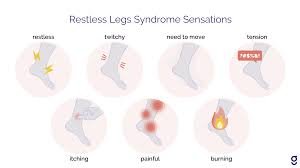Restless Legs Syndrome (RLS) is a neurological disorder that causes an uncontrollable urge to move the legs, often accompanied by uncomfortable sensations. For those struggling with sleepless nights and constant discomfort, finding an effective treatment is crucial. Gabapentin 400 mg, the active ingredient in the brand-name drug Neurontin, has emerged as a promising option. But does it work? Let’s explore how Gabapentin functions, its benefits, potential side effects, and whether it could be the right choice for your RLS symptoms.
Understanding Restless Legs Syndrome (RLS)
RLS, also known as Willis-Ekbom Disease, is characterized by:
- An irresistible urge to move the legs, usually due to uncomfortable sensations like tingling, crawling, or itching.
- Symptoms worsening at night or during periods of rest.
- Temporary relief with movement, but discomfort returns when still.
The exact cause of RLS remains unclear, but researchers believe it involves dopamine dysfunction and iron deficiency in the brain. Genetics, pregnancy, and chronic diseases like diabetes may also contribute.
How Gabapentin 400 mg Works for RLS
Gabapentin 400mg extended-release tablets (Horizant) treat restless legs syndrome (RLS), which causes discomfort in the legs and a strong urge to move them, especially at night and when sitting or lying down.
Gabapentin, sold under the brand name Neurontin, is an anticonvulsant originally developed for epilepsy. However, doctors soon discovered its effectiveness for nerve-related conditions, including neuropathic pain and RLS.
Mechanism of Action
Gabapentin modulates the activity of calcium channels in nerve cells, reducing abnormal electrical activity in the brain. For RLS, it helps by:
- Calming overactive nerves that cause restless sensations.
- Enhancing GABA (gamma-aminobutyric acid), a neurotransmitter that promotes relaxation.
- Improving sleep quality by reducing nighttime leg movements.
Unlike opioids or dopamine agonists (which carry risks of dependency and augmentation), Gabapentin offers a non-habit-forming alternative for long-term RLS management.
Effectiveness of Gabapentin 400 mg for RLS
Gabapentin 400mg capsules, tablets, and oral solutions are used along with other medications to help control certain types of seizures in people with epilepsy. They are also used to relieve the pain of postherpetic neuralgia (PHN, the burning, stabbing pain or aches that may last for months or years after an attack of shingles).
Clinical studies and patient reports suggest Gabapentin 400 mg can significantly alleviate RLS symptoms. Key findings include:
- Reduction in sensory discomfort (tingling, crawling sensations).
- Decreased frequency of leg movements during sleep.
- Improved sleep duration and quality.
A study published in Sleep Medicine found that Gabapentin enacarbil (a prodrug of Gabapentin) was highly effective for moderate-to-severe RLS. While Gabapentin 400 mg may not work for everyone, many patients experience noticeable relief within a week of starting treatment.
Dosage and Administration
For RLS, doctors typically recommend:
- Starting dose: 100–300 mg at bedtime.
- Effective maintenance dose: 400–600 mg, taken once daily in the evening.
- Maximum dose: Up to 1,800 mg daily (in divided doses for severe cases).
Best Practices:
Take Gabapentin at the same time each night for consistent relief.
Avoid alcohol, as it can increase drowsiness and dizziness.
Do not stop suddenly—taper off under medical supervision to prevent withdrawal symptoms.
Potential Side Effects of Gabapentin 400 mg
While Gabapentin is generally well-tolerated, some users may experience:
Common Side Effects
- Drowsiness or fatigue
- Dizziness
- Mild headaches
- Nausea
Less Common but Serious Side Effects
- Swelling in extremities (edema)
- Mood changes (anxiety, depression)
- Uncoordinated movements
- Allergic reactions (rash, difficulty breathing)
Note: Gabapentin may cause suicidal thoughts in rare cases—seek immediate medical help if mood changes occur.
Who Should Avoid Gabapentin for RLS?
Gabapentin may not be suitable for everyone. Consult your doctor before use if you:
- Have kidney disease (dosage adjustments may be needed).
- Are pregnant or breastfeeding (limited safety data).
- Have a history of depression or suicidal thoughts.
- Take other sedatives (increased risk of drowsiness).
Gabapentin vs. Other RLS Treatments
Unlike dopamine agonists (e.g., pramipexole, ropinirole), which can cause augmentation (worsening symptoms over time), Gabapentin provides a more stable, long-term solution.
Advantages of Gabapentin 400 mg for RLS
Non-addictive
Reduces nerve-related discomfort
Improves sleep without next-day grogginess (for most users)
Lower risk of augmentation compared to dopamine drugs
Lifestyle Tips to Enhance Gabapentin’s Effects
For better RLS management, combine Gabapentin with:
- Regular exercise (moderate activity like walking or yoga).
- Iron-rich foods (spinach, red meat, lentils) are needed if deficient.
- Good sleep hygiene (consistent bedtime, cool room).
- Avoiding caffeine and nicotine, which can trigger RLS.
Final Verdict: Is Gabapentin 400 mg Right for Your RLS?
Gabapentin 400 mg (Neurontin) is a safe, effective, and non-habit-forming option for many RLS sufferers. While it may not work for everyone, its ability to calm nerve activity and improve sleep makes it a top choice for long-term relief.
Consult your doctor to determine if Gabapentin is suitable for your condition. With the right dosage and lifestyle adjustments, you could finally experience restful nights and calm legs.
















Leave a Reply